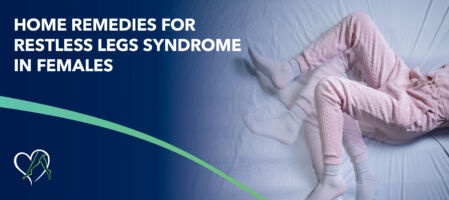
Restless legs syndrome (RLS), also called Willis-Ekbom disease, is a condition that causes uncomfortable leg sensations, such as twitching, crawling, aching, and tingling, often at nighttime. These sensations can be relieved, usually temporarily, through movement. According to the National Library of Medicine, RLS is considerably more prevalent in women than in men, possibly due to menopause, which increases the frequency and severity of RLS symptoms.
While there are still many mysteries to uncover surrounding the complex relationship between RLS and hormonal fluctuations, equipping yourself with knowledge of home therapy options can reduce uncomfortable symptoms as night falls. This blog aims to help you determine how professional intervention from one of our board-certified physicians at Center for Vein Restoration (CVR) can provide a long-term, effective solution that will give your restless legs a rest at long last.
We will explore various RLS home remedies specifically for women, offering practical tips and strategies to help alleviate uncomfortable symptoms and improve your overall quality of life.

We’ve discussed a few common symptoms of RLS, but the condition can have a range of effects. Aside from the often-reported aching, tingling, twitching, and crawling, other signs include:
Meanwhile, according to the Cleveland Clinic, several medical conditions can onset in addition to RLS. These include:
Some people who have RLS can recognize their triggers—activities that worsen their symptoms—such as drinking alcohol or taking certain medications. Triggers can make symptoms exponentially worse near bedtime or when patients are already sleep-deprived. Other potential triggers include:
According to the Better Health Channel, symptoms of severe RLS cases have been treated using anti-Parkinson disease medications, benzodiazepines, morphine, and some anti-epileptic medications. These are typically explored after steps have been taken to treat any underlying condition associated with possible triggers, for example, cutting back on caffeine, nicotine, and alcohol. Correcting iron deficiency is also a critical step of the RLS treatment process.
While consulting with one of our board-certified vein experts can provide personalized insight into the cause of your RLS and how to best treat it, there are several emerging home remedies women can use to provide temporary relief, helping them improve the much-needed sleep that can continue to give a symptomatic wellness boost.
Using a warm or cold compress on the legs or switching between hot and cold treatments can provide relief from RLS symptoms. For extra comfort, consider taking a hot bath and carefully rubbing your leg muscles.
Medical-grade compression stockings are crafted to apply pressure to the legs, helping to alleviate discomfort. These stockings can be bought over the counter or, for a customized fit, can be measured and specially ordered through your expert CVR physician.
Incorporating stress management techniques such as deep breathing exercises and meditation can be effective in improving RLS symptoms. These calming practices help patients reduce overall stress levels, which may help lessen the intensity and frequency of uncomfortable symptoms.
Developing and sticking to a fitness routine that’s well-suited for your physical health can work wonders in treating restless legs, especially for pregnant women. Ask your physician about which exercises are ideal based on your medical history.
However, don’t gear up for a workout too late at night: according to WebMD, RLS patients should stop exercising within a few hours of bedtime to avoid feelings of overactivity that may follow.
It sounds tricky when you’re having trouble sleeping due to the uncomfortable symptoms of RLS, but it’s true. Getting into a consistent rhythm of sleep, which means waking up and going to sleep at the same times each day, can help ease restless legs symptoms.
Some RLS patients have experimented with electrically stimulating their feet and toes for relief. This is typically done using vibrations or electrical impulses through various devices. Ask your doctor if you’re interested in giving it a try.
If you’ve already tried increasing your iron intake, experimenting with other supplements, such as magnesium, folic acid, or vitamin B12, may help you find relief from the achy, irritable legs that RLS causes.
Many times, finding natural relief from RLS symptoms comes from experimenting with different lifestyle changes. We’ve mentioned that alcohol, caffeine, and nicotine can worsen RLS symptoms, so eliminating them entirely can help them settle down at night. These long-term changes can improve other aspects of your quality of life, too.
Meanwhile, those who are overweight or obese may find relief from managing their weight. According to Verywell Health, a 2009 study revealed that obesity and excess abdominal fat could increase the risk of RLS. Previous research has also indicated that irregularities in dopamine levels, a key brain chemical, might be associated with the condition. This suggests that an imbalance in dopamine could contribute to the development or exacerbation of the condition, making health management—physical and emotional—even more important.
These home remedies are a great way to experiment with achieving short-term relief from the symptoms of RLS. Remember, though, that they won’t address the core issue, and some of them require more thorough research to understand relationally with the condition. In any case, none of these remedies work as a substitute for professional treatment—that’s where we come in.
The caring and compassionate physicians at CVR are honored to hold your trust as we help you manage uncomfortable symptoms of vein disease and achieve a quality of life you never thought was possible. Call our hotline today to schedule an appointment and explore your treatment options at 240-965-3915. You can also schedule ONLINE.
